Things You Should Know About Naples
 I admit that I was apprehensive before my first visit to Naples a few months ago. Armed with great pre-trip advice from people who know and love the city, bolstered by on-the-ground help from a local tour guide, and taken in by the warmth of the people I met along the way, I ended up falling in love with Naples and have been dreaming about a return ever since.
I admit that I was apprehensive before my first visit to Naples a few months ago. Armed with great pre-trip advice from people who know and love the city, bolstered by on-the-ground help from a local tour guide, and taken in by the warmth of the people I met along the way, I ended up falling in love with Naples and have been dreaming about a return ever since.
But often when I tell people how much I enjoyed my stay in Naples, I’m met with a knee-jerk reaction or surprise and/or resistance, sometimes from people who’ve never even been there. Why? Well, Naples is a city preceded by its reputation. Sure, some of the rumors about Naples are true – but not all of them. And, in my opinion, none of them are reason enough to not go to Naples. This city may require that you pay a bit more attention as a tourist, but that doesn’t mean you should scratch it off your list.
In the months since my trip to Naples, I’ve encouraged others to visit the city – and I’m pleased to say they’ve returned with stories of how much they loved it, too. So I wanted to put some of the advice I gave them in an article here for all of you.
Here are some things you should know about Naples before you go.
Sure, Naples is dirty – but so are many other big cities in the world.
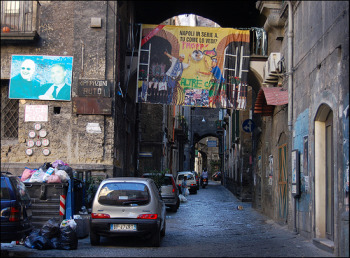 One of the stereotypes you may hear about Naples is that it’s dirty, and people even use this as an excuse to not visit the city. What, I wonder, constitutes a clean city? Would any of the people who screw up their noses as they say, “Naples is dirty” say the same things about New York or London or Paris? Because I don’t know about you, but if I drop a piece of food on the ground in any big city around the world, I’m sure not going to pick it up and eat it.
One of the stereotypes you may hear about Naples is that it’s dirty, and people even use this as an excuse to not visit the city. What, I wonder, constitutes a clean city? Would any of the people who screw up their noses as they say, “Naples is dirty” say the same things about New York or London or Paris? Because I don’t know about you, but if I drop a piece of food on the ground in any big city around the world, I’m sure not going to pick it up and eat it.
Okay, I’m being a little flippant here, but anyone who expects a city the size of Naples to be “clean” (whatever that means) is expecting too much. There is definitely room for improvement in the overall cleanliness department in Naples, but the grittiness of Naples is no reason not to visit.
The streets in the tourist areas of Naples are not piled high with garbage.
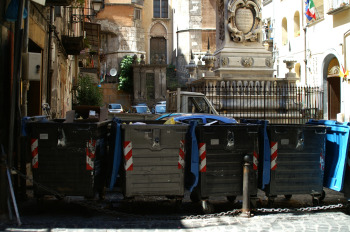 This point is related to the first one, but it deserves to be called out on its own. Naples is often in the news we get in the U.S. for not the best of reasons, so you may have heard about the garbage collection strikes last year and how there were burning piles of trash in the streets.
This point is related to the first one, but it deserves to be called out on its own. Naples is often in the news we get in the U.S. for not the best of reasons, so you may have heard about the garbage collection strikes last year and how there were burning piles of trash in the streets.
There are certainly problems with the garbage collection in Naples, and there have been for years – that wasn’t the first time there’s been a strike of the trash collectors, and it’s likely not to be the last. But the vast majority of the “piles of garbage” were not in the tourist areas of Naples, even at the height of the problem last year. Most of the trash piles were in some of the more modern parts of the city, and even further out, into the suburbs.
But an even more important point is that you probably never heard the conclusion of that story, so you may think that the people in Naples are still dodging piles of trash. Let me assure you, they’re not. It’s back to business as usual in Naples now, so go without fear of having a burning pile of garbage obstructing your view of the historic sights.
>> Note that this was true when it was first written, and also that the garbage-in-the-streets problem comes and goes with some regularity in Naples. I’ve since been there when there was, in fact, garbage in the streets of the historic center – and life went on as usual. It’s disconcerting, but that alone shouldn’t keep you from going.
Is there a Mafia problem in Naples? Absolutely. Will you even notice it as a visitor? Probably not.
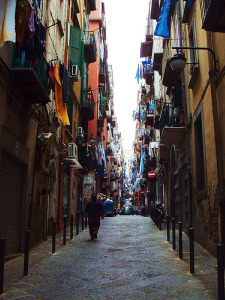 Another common stereotype you hear about Naples is that it’s dangerous. This stereotype, like many, has some truth behind it, but let’s break it down a little bit so that it’s useful from the traveler’s perspective – because your experience as a visitor is going to be very different from the experience you’d have if you lived there.
Another common stereotype you hear about Naples is that it’s dangerous. This stereotype, like many, has some truth behind it, but let’s break it down a little bit so that it’s useful from the traveler’s perspective – because your experience as a visitor is going to be very different from the experience you’d have if you lived there.
Naples (and the region) has a serious historic and ongoing problem with organized crime. There’s no getting around that. But for the most part, that level of crime doesn’t impact tourists. You might hear reports about how the Camorra (the Naples Mafia) controls certain local industries (such as garbage collection) which are then completely corrupt. But as big of a problem as that may be, if you’re just visiting you probably don’t care what happens to the trash after you drop it in your hotel room’s waste bin.
On the other hand, Naples also has a higher-than-average rate of petty theft, which does impact tourists. The two most common crimes in Naples are purse snatching and jewelry theft, and you should absolutely take precautions against both. Naples isn’t unique in this department, since there are pickpockets and purse snatchers targeting tourists in big cities around the globe every day, but if you’re a careful person you’re less likely to look like – or become – a victim.
As I said earlier, Naples’ reputation reaches you long before you reach the city, so it’s natural to arrive with your guard up. And, as fate would have it, that’s probably not entirely a bad thing. But having your guard up and having a chip on your shoulder are two different things.
The pizza really is better in Naples.
 Some pizza lovers will say they prefer the pizza in Rome, but don’t listen to them. There’s perfectly good pizza in Rome, don’t get me wrong – but the pizza in Naples is an entirely different beast. And since it was Naples where the pizza originated, I’m gonna go with Naples on this one.
Some pizza lovers will say they prefer the pizza in Rome, but don’t listen to them. There’s perfectly good pizza in Rome, don’t get me wrong – but the pizza in Naples is an entirely different beast. And since it was Naples where the pizza originated, I’m gonna go with Naples on this one.
Now, depending on who you talk to, you’ll get pointed to different pizza places in Naples as the ones with “the best pizza” or “the most authentic pizza” or what have you. I have a favorite, but I also know passionate and smart people who have a different favorite, so I’m willing to believe there’s plenty of great pizza to be had in Naples. In fact, I encourage you to try several places and pick your own favorite.
There are places serving bad pizza in Naples, but keep your eyes open and you’ll be able to steer clear of them. Any pizza joint with a crowd of locals milling out front is a good one to try, and if the sign overhead says “vera pizza napoletana” that’s usually a good omen, too.
>> And here’s a bonus bit of pizza knowledge for Naples – did you know you can order a small pizza if your appetite isn’t up to the standard size? Thanks to a tweet by @ABrushWithItaly I found out that you can order a “mignon” pizza (pronounced like the French, meen-YON). Good to know!
Naples is an enormous and sprawling city – but the historic center is fantastically compact and ideal for exploring on foot.
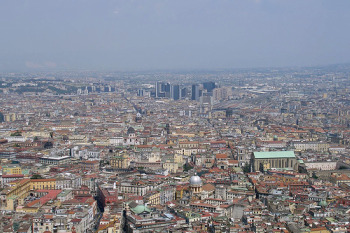 It’s hard to get an idea of how big Naples is when you’re in it, but if you have the good fortune of taking a boat to Sorrento or one of the islands off the coast and can look back at the city from the water, you’ll see just how gigantic it is. Buildings crawl practically halfway up the side of Mt. Vesuvius, and fill every visible nook and cranny of the land.
It’s hard to get an idea of how big Naples is when you’re in it, but if you have the good fortune of taking a boat to Sorrento or one of the islands off the coast and can look back at the city from the water, you’ll see just how gigantic it is. Buildings crawl practically halfway up the side of Mt. Vesuvius, and fill every visible nook and cranny of the land.
It’s overwhelming, and I’m quite glad I didn’t see that view until I’d been in the city for a couple days and already taken a liking to it.
The thing is, as is the case with many historic cities in Italy and elsewhere, there are two sides to Naples – an historic side, and a modern side. The modern city of Naples is the sprawl, and although there are some things tucked into that sprawl that visitors might find interesting (especially more intrepid travelers and/or those who have visited the city before), the majority of the stuff that tourists will want to see and do in Naples is in a pretty small part of the city.
The area called the centro antico (the “ancient” center) is incredibly compact and makes a great base for a visit. Beyond the boundaries of that maze of ancient streets there are lots of museums and galleries that are within walking distance or reachable by a short bus ride. In other words, don’t let the hugeness of Naples freak you out. Just concentrate on the historic parts and ignore the rest of it.
Naples is hilly.
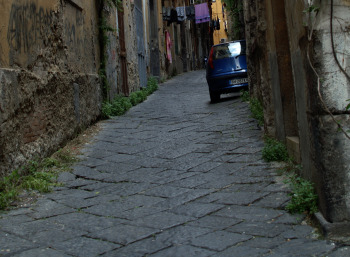 Having said all that about exploring the historic center on foot, let me at least warn you that before you glance at a tourist map and determine that a certain distance “looks walkable” you should probably consult with someone local. Naples is deceptively hilly, and although most of the centro antico is fairly flat it’s a walk either uphill or downhill to get to the port, to the National Archaeological Museum, to the train station… Just about anywhere.
Having said all that about exploring the historic center on foot, let me at least warn you that before you glance at a tourist map and determine that a certain distance “looks walkable” you should probably consult with someone local. Naples is deceptively hilly, and although most of the centro antico is fairly flat it’s a walk either uphill or downhill to get to the port, to the National Archaeological Museum, to the train station… Just about anywhere.
In fact, there’s a popular palace and museum bearing the name “Capodimonte” that’s well worth a visit – but you should know that the name “Capodimonte” means “top of the hill.” And they’re not kidding about the hill. Luckily, there are a few “funicular” cable cars that scale the hillsides so that you can visit things like the Capodimonte Museum and the Vomero neighborhood.
If you like the whole stepping back in time experience you get in Rome, you’ll love Naples.
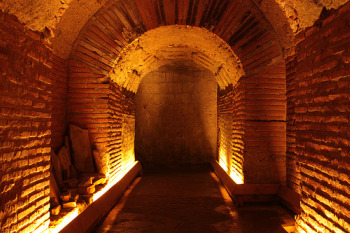 One of the allures of Rome is all that “old stuff” – the Colosseum standing proudly at the end of a modern street full of modern traffic, buildings from a few centuries ago overlooking the Forum ruins of a couple millennia ago. It’s heady stuff. But even though ancient Rome is very much a part of the Rome of today, it still feels a little bit like a museum piece, what with the un-crossable rope lines and admission fees and whatnot.
One of the allures of Rome is all that “old stuff” – the Colosseum standing proudly at the end of a modern street full of modern traffic, buildings from a few centuries ago overlooking the Forum ruins of a couple millennia ago. It’s heady stuff. But even though ancient Rome is very much a part of the Rome of today, it still feels a little bit like a museum piece, what with the un-crossable rope lines and admission fees and whatnot.
Naples, on the other hand, is a museum piece that’s still very much alive. It’s one of the oldest cities in the western world, and was an important Greek city as far back as the 8th century BCE. In the historic center of today’s Naples, you walk down ancient streets alongside speeding Vespas, and wander in and out of shops in historic buildings – and there’s not a rope line in sight. Those shops, businesses, and apartments you’re walking by have been there for centuries – it’s only the people in them (and the stuff they’re selling) that has changed.
Like Rome (and many cities in Italy), much of Naples’ history is also underground – and it’s history you can visit with a trip into the basement of the San Lorenzo Maggiore church where you’ll find a partially excavated Roman market. What’s more, it’s not just ancient Roman ruins you get a glimpse of right in the heart of Naples but also the Greek ruins that are buried underneath the Roman ones. There are layers of history here, and a visit in Naples is bound to make anyone feel a little bit like an archaeologist.
Y’know how in many cities the neighborhood around the train station isn’t a place you’d want to hang out? That’s even more true in Naples.
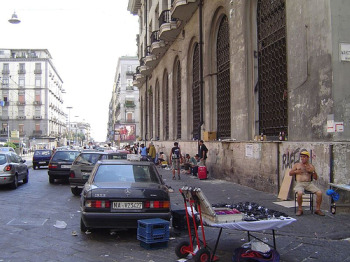 In just about every city I’ve ever been to, the area right around the train station isn’t exactly the prettiest part of town. But in many of those places, that neighborhood is reasonably safe and even where I stay when I visit. In Naples, however, I don’t recommend that.
In just about every city I’ve ever been to, the area right around the train station isn’t exactly the prettiest part of town. But in many of those places, that neighborhood is reasonably safe and even where I stay when I visit. In Naples, however, I don’t recommend that.
There’s nothing so dangerous about the neighborhood around the Naples train station that should make you afraid to arrive in the city by train, but this is one of the parts of town where some of the people I met in Naples (the ones who live there) said I shouldn’t go after dark, especially as a woman traveling alone.
In addition to the generally unsavory atmosphere around the train station, I also think it’s unwise to book a room in a hotel in this area because it’s too far from the historic center (where you want to be – trust me). You aren’t likely to want to make that trek on foot in the daylight, and it’s even less appealing at night. I know there are a bunch of cheap places to stay right around the train station, but I still suggest you find a place in the historic center. You’ll be happier, and the chances are better that you’ll like the city, too.
The cabbies in Naples are not all out to rip you off.
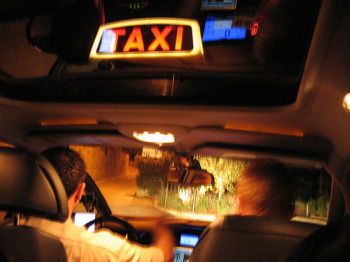 There are well-documented stories of how taxi drivers in Naples (and Rome, for that matter) charge unsuspecting tourists exorbitant fares. But if you ever hear “all the taxi drivers in Naples overcharge passengers,” you can call that what it is – baloney.
There are well-documented stories of how taxi drivers in Naples (and Rome, for that matter) charge unsuspecting tourists exorbitant fares. But if you ever hear “all the taxi drivers in Naples overcharge passengers,” you can call that what it is – baloney.
Most of the ugly stories you’ll hear about cabbies in Naples involve them either not turning on the meter or claiming it’s broken, and then demanding some outrageous fare when they’ve already driven you where you wanted to go. Every taxi I got into in Naples had a working meter that the cabbie turned on immediately, and I’ve heard from other travelers that they didn’t have problems with the taxis, either.
It’s likely that there are still some taxi drivers in Naples who will try to pull this stunt, but there’s an easy fix for it – if they don’t turn on the meter when you’re getting in the cab and they won’t turn it on upon request, get out of that taxi and choose another one. But please don’t assume all taxi drives in Naples are cheats. And you never know, some of them might just entertain you.
Naples lets you get off the beaten path – without getting off the beaten path.
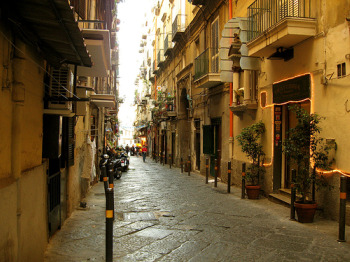 Many travelers to Italy don’t go south of Rome. And many who do venture south avoid Naples because, let’s face it, the city has a bad rap. So if you’re one of the people who’s trying to avoid tourist crowds but doesn’t want to rent a car and drive to some tiny and remote town in Basilicata to do so, look no further than the city of Naples.
Many travelers to Italy don’t go south of Rome. And many who do venture south avoid Naples because, let’s face it, the city has a bad rap. So if you’re one of the people who’s trying to avoid tourist crowds but doesn’t want to rent a car and drive to some tiny and remote town in Basilicata to do so, look no further than the city of Naples.
Naples is the big city that’s hidden in plain sight. Depending on what stats you look at, it’s either the 2nd or 3rd most populous city in Italy, and yet even at the height of tourist season you won’t find the same crowds as you do in Rome, Venice, or even pint-sized Verona. Heck, miniscule Sorrento is crawling with tourists (and kitschy souvenir shops) when nearby Naples is not.
As I’ve noted above, some of this is easily attributed to the reputation Naples has as being dirty or dangerous. But as I’ve also explained, those alone are not reason enough to skip Naples – and the absence of crowds actually makes it more desirable to go.
photos, top to bottom, by: the pink sip, Daveness_98, Jessica Spiegel (and may not be used without permission), Schantzilla, dawvon, Argenberg, Jessica Spiegel (and may not be used without permission), feline_dacat, scalleja, Patrik Axelsson, Sami Keinänen